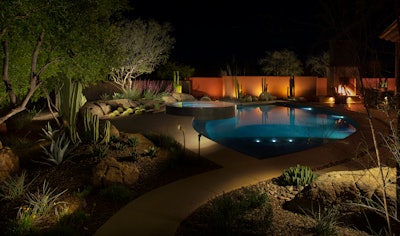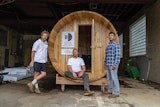

Lighting a landscape, especially alongside a pool and spa, can create both visual nuance and drama not possible during daylight hours. The project featured here was one where several breakthroughs occurred in my own understanding of how to apply lighting. The landscape and pool design transformed an attractive but unassuming home into a unique expression of the clients' tastes and ideals, but the lighting was the finishing touch that elevated it to an entirely new level.
I am especially grateful that I had the opportunity to consult and work closely with landscape lighting master Janet Lennox Moyer. Collaborating with a designer of her caliber provided a priceless lesson in what you can achieve using strategic lighting techniques.
Janet has a beautiful artistic sense of how to accentuate the character of organic forms. Of the many lighting treatments on display in this project, nearly all were chosen to reveal the drama of the plants, not just the architecture.
In this case, the plant palette is comprised of cacti, succulents and trees indigenous to desert climes. There's a sculptural quality to these plants that make them perfect subjects for the interplay of light and shadow.
RELATED: LEDs: The New Direction of Pool Lighting
We used nearly 200 LED fixtures from FX Luminaire, including different types of suspended downlights, uplights, in-grade well lights and directional lights that were usually post-mounted or mounted to the eave of the house or a wall. We intentionally avoided the use of path and stair lights, which we consider visually intrusive.
A myth that Janet dispelled for me was that more lights do not equal greater brightness. It's counterintuitive, but what we perceive as uncomfortable brightness is actually contrast. A few singular lights surrounded by a majority of darkness is hard on the eyes because they are struggling to adapt to either the bright areas or the dark. When we add more fixtures to fill in and connect illuminated spaces, no one area falls off into darkness. The overall effect is very pleasant and easy on our eyeballs. It feels soft, not bright.
That principle and many other ideas are on full display throughout this landscape. Combined with the luminous water of the pool and spa, or with its dark reflective surface when the pool lights are off, the creative possibilities dramatically increase.

OUT FRONT
One of the many things Janet taught me is to treat the home's entrance as the main focus, and as such, it is where you concentrate the most light. From there, you're working outward in both directions into layers of diminishing brightness. With the front entry serving as the primary visual "destination," the uplit ironwood trees to either side create the next visual tier in the hierarchy of perceived brightness, the lead singers in the band, so to speak. Finally, the third layer is comprised of all the elements on the ground, which provides depth and texture, and more importantly, links the various zones together by making sure no areas falls off into total darkness. These are the background vocals that support the main players.
The trees are lit with three or four well lights each, fully capturing the interesting forms of their branches, which lend character to the setting. At least three fixtures were required for two reasons. First, these trees were visible from multiple viewing angles, so we had to be sure they were fully lit from all sides. Second, the light behind a subject is what causes it to pop off the background, giving it a rounded three-dimensional character rather than looking flat.
RELATED: Illuminating Possibilities
A great subtle-yet-obvious tip once you know it: The way you uplight a tree is to not put the light under a branch, but instead position it in the void between branches. This allows the light to fully translate all the way up into the canopy, creating a glow from within. The added benefit is that the branches at the base are lit more softly by this side placement instead of glowing hot from having a light just beneath it. Seek to avoid hot spots and glare at all costs.
Accompanying the ironwoods are hanging downlights directly above focal elements on the ground, which create a moonlighting effect. Golden barrel cactus, agave and the boulders give the trees context so they are not floating free in a black expanse, which meant they needed to be lit as well. Lighting low-profile landscape elements always means downlighting or side lighting, which is why finding places to mount downlights is an ongoing and important challenge.
In order to succeed at downlighting, you sometimes have to get creative and go the extra mile to locate fixtures discreetly. For example, just to the left of the walkway in front of the house we built a faux ocotillo "post" structure out of rebar to blend right into the ocotillo plant already there. The fixtures and the rebar disappear; you only perceive the illumination. Without this effort, all of the ground plantings by the pathway would be dark. Or worse, path lights would have been the default, creating a runway effect.
Finally, as you approach the front door, a large Hercules aloe welcomes you to the entry courtyard. This beautiful specimen is uplit from the front with two well lights, one on each side at 45 degrees from center. But most importantly, it is downlit from behind by a directional fixture mounted just above it in the eave.
It took a lot of effort and resolve to get this fixture in. A downspout gutter 60 feet away was employed to get the wire up to the eave, and then it was tucked under the concrete roof tiles all the way around. In studio portraiture photography this technique is known as three-point lighting. This particular aloe is striking by day, but even more so at night. The effort to showcase this specimen the way it deserved paid great dividends and truly amplified the sense of arrival as one approached the front door.

SHAPING THE VIEW
Moving to the back, the basic layout of the landscape and the teardrop shape of the pool were all dictated by the natural movement through the space. This view is from a path that leads from the west gate near the master bedroom toward the pool and main patio areas.
Part of the project involved removing an existing perimeter wall the first occupants placed closer to the house than it should have been. Relocating the wall allowed us to capture space that had been originally forfeited to the exterior side yard, but it also presented a greater opportunity. Rather than just one continuous wall, a more intriguing backdrop and visual boundary was made by composing the wall as overlapping panels offset from each other. The panels were then finished in different colors to give each its own identity, further dissolving the fact that the property was "walled in." The wall colors were inspired by both the desert and material palette of the patio and interior flooring.
As in the front yard lighting, a hierarchy was imparted to the color scheme to direct the eye and add dimension. The main focal point wall panels were painted a vivid copperorange, the intermediate walls were rendered with a deeper brick red and the backdrop wall in the distance was painted the darkest color, a deep chocolate brown to recede into the shadows. This sequence of colors was selected to create visual depth from the flatness that can otherwise be had by an enclosing wall.
RELATED: Why LED Lights are Taking the Industry by Storm

Looking across the pool, your eye is first drawn to the concave copper-colored wall panel, which serves as the glowing background to silhouette a trio of backlit Mexican fencepost cacti. The fixtures provide a wide, soft light that is perfect for this type of effect because you can have them fairly close to the base of the wall and still have an even spread of light across the surface. In this setting, the lighting defines an almost gallery-like presentation of the cacti, creating an eyecatching vignette that invites you to move toward that side of the yard.
Side note: We used a lot of well lights and several dozen small boulders throughout the property to conceal the fixtures' locations, shielding the eyes from glare. It's important to always look for ways to hide the light sources so they neither shine in the viewers eyes nor draw attention to themselves.
A final note of appreciation: Rick Chafey, Brett Blauvelt and their colleagues at Red Rock Pools & Spas in Mesa, Ariz., were instrumental in every aspect of this project.

READY FOR A CLOSE UP
This prickly pear cactus will be easily measure 8 feet in diameter one day, but for the time being it's just a pup. Even now, however, it presents beautiful shapes, rich color and patterned skin. We lit it with two wash lights from opposing 45-degree angles to capture its face from two sides while also casting twin shadows on the wall in the background. Had it been lit with just one light, which seems to be the industry default, it would create almost ghoulish-looking shadows and make the cactus appear smaller than it is. Lighting it from at least two points enlivens and celebrates its form, almost foreshadowing its future larger self.
THE CENTERPIECE
Everything about this scene is strategic, using depth, reflection and texture to create a signature view looking from the main deck area across the pool.
Ironically, this scene starts with what you almost don't see. Unlike the flanking red and orange wall panels, the central dark brown wall in the background is meant to recede from view, leaving a void of shadowy depth from which the glowing foreground elements "pop." We used two upsized versions of the wall wash lights to accentuate the ironwood's elegant branch structure. The silvery tree appears to almost float out of the darkness, independent of the background.
RELATED: Lighting And Aquatic Features Go Hand In Hand
Celebrating the tree's artful form, a strategically located vanishing edge spa serves as a mirror, situated within a prime viewing angle from the home's interior.
Embellishing the scene are two suspended tree lights that moonlight the agaves, showing off their dramatic form and detail. To accentuate texture, we side-lit the golden barrels to the right of the tree using a directional fixture hidden in the overlap between the red and orange wall panels approximately 20 feet away. The golden barrels on the left were lit from a directional light on a small pole inconspicuously located to the side of the deck.
CONCEAL AND REVEAL
As you move to the left of the spa behind the pool, the scene continues to unfold with a rhythm of highlights and visual texture. In this view, we used the dense, dark foliage of three Texas ebony trees to obscure the undesirable view of the neighbor's house. Rising above the wall as the finishing background layer, we uplit the preexisting mature ironwood that was on the outside, adding depth and distance to finalize the backdrop and fill in what would have otherwise been a dark hole in the composition if left unlit.
We hit all of these notes throughout the entire landscape over and over in different combinations, varying the textures of light.












































